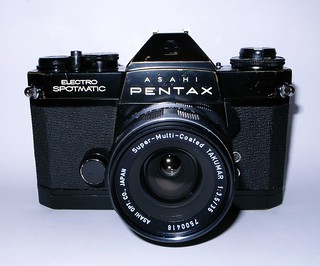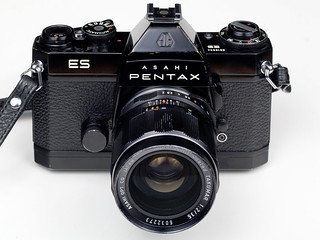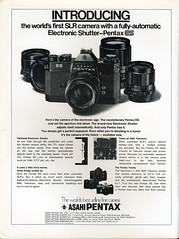Pentax ES
|
|||
| |||
|
The Pentax ES was announced by Asahi in 1971, as a continuation of their succesful Spotmatic cameras, [1] as the world's first SLR with 'fully-automatic electronic shutter'.[2] The Electro Spotmatic was designed by Mr. Minoru Suzuki. The first lot of cameras was limited to Japan, where testing was carried out, as electronics at the time were finicky and not reliable. Several improvements were carried out for the production model for export simply named the ES and the home market as Asahi Pentax Electro Spotmatic. About 70,000 were made.[3] It was available in black (Asahi, Honeywell) and chrome (Honeywell) body versions and was followed by the ES II in 1973.
The ES was the first Pentax with open-aperture metering, enabled by Pentax's proprietary addition of aperture meter coupling to the familiar M42 thread mount.
This camera offers what has since become familiar as aperture priority automatic exposure (shutter priority AE was already possible with other cameras, such as the Canon F-1, at this time). Electronic shutter timing makes aperture-priority AE possible because it allows the shutter speed to be essentially continuously variable, not restricted to whole or half-stop values. Manually-set shutter speeds on the ES are mechanically timed, however (and so not dependent on the camera battery, so the camera is fully operable (though without metering) at all normal hand-held speeds, in the event of battery failure). The ES also makes an early use of a memory circuit in exposure control, to store the exposure setting in the brief period of 'blackout' when the mirror is moved to allow exposure.
Asahi [4] emphasized the advantage that, since the mechanisms involved in this mode of AE were in the camera body, not the lens, the camera could be used, in AE, with all existing Super-Multi-Coated Takumar lenses that have a light meter coupling [5](in contrast, shutter-priority systems like Canon's had required the development of new lens mounts incorporating rapid stop-down mechanisms). Other M42 lenses could also be used but they had to be in the working aperture and could not achieve fully-open light metering.
The body of the Pentax ES is slightly taller than the other Spotmatic bodies, to accommodate the electronics which are under the bottom plate which is deeper. A 6V battery was used to power the camera, and it was located in the front of the body, where the self-timer mechanism is in the rest of the Spotmatics, thus the self-timer was omitted.[3]
McKeown describes the early-generation electronics of the ES as unreliable, even though they had improvements from the prototype run, especially after long years of use.
Specifications[4]
Camera type: 35 mm SLR camera with TTL metering and aperture-priority AE
Lens mount: 42x1mm thread (Pentax screw mount)
Standard lens: 55 mm f/1.8 or 50 mm f/1.4 Super Multi-Coated (SMC) Takumar.
Shutter:
- Horizontally-running focal plane shutter with electronic or mechanical timing
- In AE, shutter speed is continuously variable from 8 seconds to 1/1000 second
- Mechanically timed shutter speeds 1/60 - 1/1000 second and 'B' can also be set manually
- No delayed action
- Shutter cocked by advancing the film (shutter-cocked indicator: red dot in window next to shutter release)
Metering:
- CdS Through-the-lens meter. Usable in full-aperture AE or stopped-down metering.
- Sensitivity EV 1-18 at ISO 100.
- Exposure compensation -1 to +2 stops offset possible (dial around rewind crank)
- Film speeds ISO 20-1600 can be set (dial around rewind crank)
Flash synchronisation: Hot shoe (synchronised for X-synch. at 1/60 sec) and separate PC sockets beside lens mount for X- and FP-synch.
Viewfinder:
- Pentaprism viewfinder.
- Fresnel focusing screen has a central microprism focusing aid.
- Meter scale at right hand side shows shutter speeds 1-1/1000 second.
Film advance: Single-stroke winding lever.
Film rewind: folding crank; rewind release button on base.
Depth-of-field preview (and stop-down for stopped-down metering): lever to left of lens mount to be used in preference to the lens' stop-down lever.
Dimensions (width x height x depth): 143 x 98 x 91 mm (presumably with standard lens fitted)
Weight: 940 g (presumably with standard lens fitted)
Battery: One 4SR44/PX28A 6V silver oxide battery. Battery compartment to the right of the lens mount.
Battery check button next to rewind crank (meter needle should fall below 1/30 sec mark)
Notes and References
- ↑ , According to Pentax Imaging (archived)]; McKeown dates it to 1972; probably the difference between announcement and actual availability.
- ↑ Pentax Imaging (archived) states more explicitly that the ES was the world's first SLR with through-the-lens aperture-priority AE.
- ↑ 3.0 3.1 Gerjan van Oosten, 2021, "The Definitive ASAHI PENTAX Collector's Guide 1952-1977". 2nd Edition ISBN978-90-9034415-7
- ↑ 4.0 4.1 User's Manual for the ES (pdf) at Pentax Imaging
- ↑ Evolution of the M42 mount by stevebrot at pentaxforums.com
Bibliography
- Gerjan van Oosten, 2021, "The Definitive ASAHI PENTAX Collector's Guide 1952-1977". 2nd Edition ISBN978-90-9034415-7
- Herbert Keppler, 1974. The Pentax Way. 8th ed ISBN 0-240-50889-0
- Walter D Emanuel. 1979. The Asahi Pentax Guide, 21st ed, Focal Press ISBN 978-02-4044874-9
- Camera and lens literature at Kim Coxon's manual site


